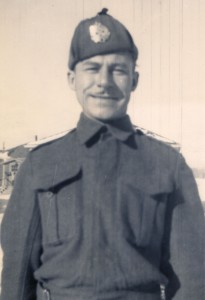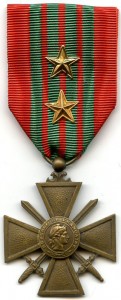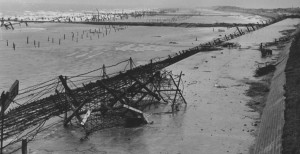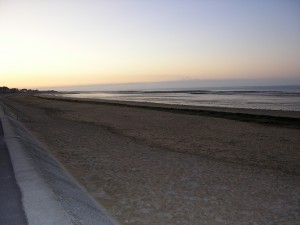Canadian Scottish Stretcher Bearer on D-Day
Sergeant William Garner
Croix de Guerre avec Etoile De Bronze (France)
On 6 June 1944 (D day) at COURSEULLES-sur-MER, France, K57764 Sergeant William GARNER, medical Sergeant 1st Battalion Canadian Scottish Regiment, landed with his unit on the beach amid heavy mortar and machine gun fire. Completely disregarding his own safety he began immediately to treat the wounded on the beach. While attending a badly wounded stretcher bearer, Sergeant William GARNER was hit on the face with splinters from a mortar bomb. Although bleeding very badly he continued his work and directed the work of his men until he became too weak from loss of blood to carry on. Although unable to advance with his unit Sergeant William GARNER has done his job. In addition to having treated as many wounded as possible, his display of courage and devotion to duty, inspired his stretcher bearers as they continued the advance without him, and set the very high standard which they achieved in the many battles which followed thus saving a great many lives.
Known Canadian Scottish Regimental Aid Post Soldiers
Bill Baxter
Doug Bolton
Mervyn Carlton
Jim Catteral
Dickie Duncan
William Garner
Bert Keller
Norman Lewis
Bob Trowsdale
The Regiment and D-Day
Some of the men did not get more than ten feet from the L.C.A. [Landing Craft Assault] before they were killed or wounded. The open beach made an excellent “killing ground”. The enemy knew it. So did the assault troops. The men ran across that open stretch as they never ran before, sending up fervent prayers of thanks as they did so that the sand was absorbing most of the shrapnel from the mortar bombs falling around them, and that the beach itself was not mined. So much happened in so few seconds as each man raced across the 75-100 yards of beach. A soldier would cry out, clutch his arm and feel the sticky warm blood beginning to soak his shirt. But he kept on going. Another would gasp and fall, not to rise again. (Roy, Reginald, Ready for the Fray, p.212)
Canadian Scottish Regiment Fatalities D-Day 1944
Lieutenant Francis G. Radcliffe
Private James A.E. Anglin
Private Edwin D. Boothby
Private Ronald V. Cameron
Private Robert N. Cooper
Private August J. Eckman
Private Clayton H. Evans
Private Walter E. Fahrni
Lance Corporal Andrew J. Finnie
Private Victor R.D. Garcia
Private Sigurd N. Huser
Private Leslie D. Jenkinson
Private William B. Lewis
Private Neil J. MacPherson
Private Adolph McCormack
Private Willford L. McLaughlin
Private Adolf G. Nilsson
Private Lawrence Osborne
Corporal John W.W.M. Parr
Corporal William G. Ritchie
Private John E. Stewart
Acting Lance Corporal John P. Thieme
Canadian Scottish Regiment Wounded D-Day 1944
Lieutenant James H. Russell
Lieutenant Vilheim R. Schjelderup
Lieutenant Robert E. Turnbull
Private Gordon T. Armstrong
Private James H. Ashley
Private Walter S. Barber
Corporal Maurice Barnett
Private Michael Belyan
Private William A. Brocklebank
Private John J. Buggy
Private William Bylyk
Sergeant Kenneth Byron
Private Sam Cook
Private Fred Darnton
Private Robert E. Ettinger
Sergeant James G. Forsyth
Private Benjamin M. Francis
Sergeant William Garner
Private John F. Grabish
Private Russell E. Greenwood
Private Harold D. Hammond
Private Clifford H. Hogan
Private Gunnar M.C. Hoybak
Private Philip P. Katchanoski
Private Earl L. Kellar
Private Gustave J. Kirko
Company Sergeant Major Rowland A. Knight
Private William Leier
Private Arthur S. Low
Private John A. MacIntyre
Private Gordon E. McDonald
Private Roderick R. McKenzie
Private Edward W. Morrisey
Private Emmanuel V. Neumann
Private James Nicoll
Private William O. Noon
Private Reuben Oldenburger
Private Reginald F. Oldershaw
Corporal Roy C. Parker
Private Edgar J. Parrent
Sergeant John H. Pelly
Private Andrew W. Pinchbeck
Private Michael Prokopchuk
Acting Lance Corporal Robert A. Robinson
Private William Semple
Private John Stewart
Regimental Sergeant Major James Stothard
Private Walter J. Sutyla
Private Robert W. Terry
Private Eric D. Thomson
Private John Thomson
Private Andrew F. Thynne
Private Robert Todd
Corporal Albert E. Truesdale
Private Frank W. White
Private Albert Wilcox
Private Albert W. Wilkinson
Lance Corporal Arthur Wilson





Comments